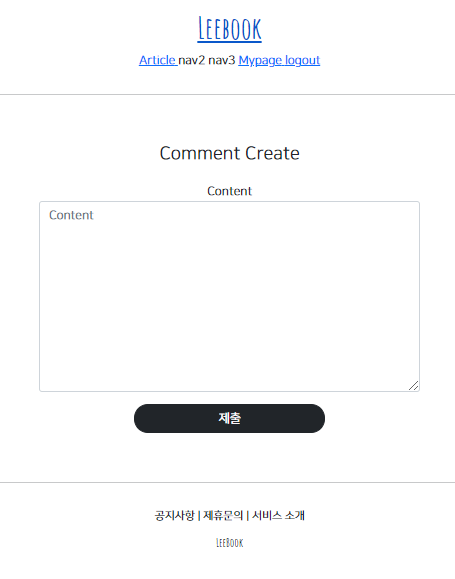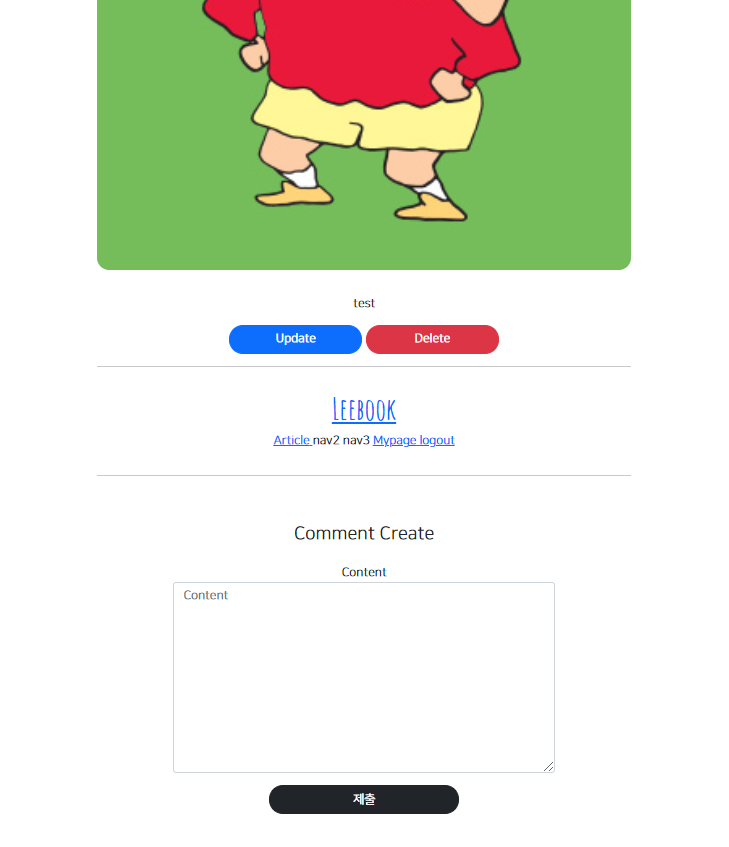
실용주의 프로그래머님의 인프런 강의를 듣고 작성하였습니다.
출처: https://www.inflearn.com/course/%EC%9E%A5%EA%B3%A0-%ED%95%80%ED%84%B0%EB%A0%88%EC%8A%A4%ED%8A%B8/lecture/62871?tab=note&speed=1.25
Comment App
- Create / Delete View
- Success_url to related article
- Model (article 어떤 글인지 /writer 글쓴이가 누구 인지 /content 댓글 내용은 무엇인지 /created_at 언제 작성되었는지)
Mixin이란? Detail view를 Form으로 하고 싶다면 Mixin을 이용해야 한다. FormMixin을 사용하면 form_class를 지정해줌으로써 deatail view에서도 form을 사용할 수 있다.
- python manage.py startapp commentapp 을 통해 commentapp 생성
- settings와 url에서 commentapp과 path를 추가
path('comments/', include('commentary.urls')),- urls.py 생성
from django.urls import path
from commentapp.views import CommentCreateView
app_name = 'commnetapp'
urlpatterns = [
path('create/', CommentCreateView.as_view(), name='create')
]- models.py에서 Comment 모델 작성
from django.contrib.auth.models import User
from django.db import models
# Create your models here.
from articleapp.models import Article
class Comment(models.Model):
article = models.ForeignKey(Article, on_delete=models.SET_NULL, null=True, related_name='commnet')
writer = models.ForeignKey(User, on_delete=models.SET_NULL, null=True, related_name='commnet')
content = models.TextField(null=False)
created_at = models.DateTimeField(auto_now=True)- views.py
from django.shortcuts import render
# Create your views here.
from django.views.generic import CreateView
from commentapp.models import Comment
class CommentCreateView(CreateView):
model = Comment
form_class = CommentCreationForm
template_name = 'commentapp/create.html'
def get_success_url(self):
return reverse('articleapp:detail', kwargs={'pk': self.object.article.pk})- forms.py 생성
from django.forms import ModelForm
from commentapp.models import Comment
class CommentCreationForm(ModelForm):
class Meta:
model = Comment
fields = ['content']- migration 작업
python manage.py makemigrations
python manage.py migrate
- create.html
<!--{% extends 'base.html' %}-->
<!--나중에 articleapp/detail.html에서 불러와서 쓸 것이기 때문에
거기서도 base.html을 extends 하기 때문에 여기서는 지워준다.-->
{% load bootstrap4 %}
{% block content %}
<div style="text-align: center; max-width: 500px; margin: 4rem auto">
<div class="mb-4">
<h4>
Comment Create
</h4>
</div>
<form action="{% url 'commentapp:create' %}" method="post">
{% csrf_token %}
{% bootstrap_form form %}
<input type="submit" class="btn btn-dark rounded-pill col-6 mt-3">
<!-- 현재 article의 pk 값을 얻어와서 나중에 article detail에 넘겨준다.-->
<input type="hidden" name="article_pk" value="{{ article.pk }}">
</form>
</div>
{% endblock %}
근데 이렇게 댓글을 달기 위해 새 페이지로 들어오는 것이 아닌 게시글에서 바로 댓글을 달 수 있도록 해야 한다.
articleapp/templates/articleapp/detail.html에서 include를 통해 저 페이지를 박아넣는다.
{% include 'commnetapp/create.html' with article=target_article %}
또한 articleapp/view.py에서 DetailView를 보면 Form이 없다. FormMixin을 가져와서 다중 상속 시켜준다.
class ArticleDetailView(DetailView, FormMixin):
model = Article
form_class = CommentCreationForm
context_object_name = 'target_article'
template_name = 'articleapp/detail.html'
이렇게 한다고 완성된 것이 아니라 서버에서 설정해줘야 할 것이 있다.
commentapp/views.py
class CommentCreateView(CreateView):
def form_valid(self, form):
temp_comment = form.save(commit=False)
temp_comment.article = Article.objects.get(pk=self.request.POST['article_pk'])
temp_comment.writer = self.request.user
temp_comment.save()
return super().form_valid(form)그 전에 commentapp/create에서 로그인 댓글을 달게 요청하는 버튼을 로그인이 되어 있을 경우에만 보여주도록 하고 로그인이 안됐을 경우 로그인하는 창으로 가도록 해준다.
{% if user.is_authenticated %}
<input type="submit" class="btn btn-dark rounded-pill col-6 mt-3">
{% else %}
<!-- next를 통해 어디로 되돌아 와야 하는지도 설정해준다.-->
<a href="{% url 'accountapp:login' %}?next={{ request.path }}"
class="btn btn-dark rounded-pill col-6 mt-3">
Login
</a>
{% endif %}이제 작성한 댓글을 보이도록 해보자
articleapp/templates/articleapp/detail.html
{% for comment in target_article.comment.all %}
{% include 'commentapp/detail.html' with comment=comment %}
{% endfor %}commentapp/templates/commentapp/detail.html 생성
<div style="border: 1px solid; text-align: left; padding: 4%; margin: 1rem 0; border-radius:1rem;
border-color: #bbb;">
<div>
<strong>
{{ comment.writer.profile.nickname }}
</strong>
   
{{ comment.created_at }}
</div>
<div style="margin: 1rem 0">
{{ comment.content }}
</div>
</div>이제 댓글 삭제 기능을 구현한다.
commentapp/views.py
class CommentDeleteView(DeleteView):
model = Comment
context_object_name = 'target_comment'
template_name = 'commentapp/delete.html'
def get_success_url(self):
return reverse('articleapp:detail', kwargs={'pk': self.object.article.pk})
commentapp/delete.html을 생성해준다.
<div style="border: 1px solid; text-align: left; padding: 4%; margin: 1rem 0; border-radius:1rem;
border-color: #bbb;">
<div>
<strong>
{{ comment.writer.profile.nickname }}
</strong>
   
{{ comment.created_at }}
</div>
<div style="margin: 1rem 0">
{{ comment.content }}
</div>
{% if comment.writer == user %}
<div style="text-align: right">
<a href="{% url 'commentapp:delete' pk=comment.pk %}"\\
class="btn btn-danger rounded-pill">
Delete
</a>
</div>
{% endif%}
</div>commentapp/detail.html에서 삭제 링크를 추가한다.
<div style="text-align: right">
<a href="{% url 'commentapp:delete' pk=comment.pk%}">
Delete
</a>
</div>url에도 당연히 추가를 해줘야 한다.
commentapp/urls.py
path('delete/<int:pk>', CommentDeleteView.as_view(), name='delete')
이 삭제 버튼을 항상 보여주면 안된다. 그 댓글을 작성한 유저만 볼 수 있도록 해야 한다.
{% if comment.writer == user %}
...
{% endif%}delete view에도 댓글의 주인을 확인하는 데코레이터를 적용시키기 위해 decorators.py를 생성하고 적용시켜준다.
commentapp/decorators.py
from django.contrib.auth.models import User
from django.http import HttpResponseForbidden
from commentapp.models import Comment
def comment_ownership_required(func):
def decorated(request, *args, **kwargs):
comment = Comment.objects.get(pk=kwargs['pk'])
if not comment.writer == request.user:
return HttpResponseForbidden()
return func(request, *args, **kwargs)
return decorated